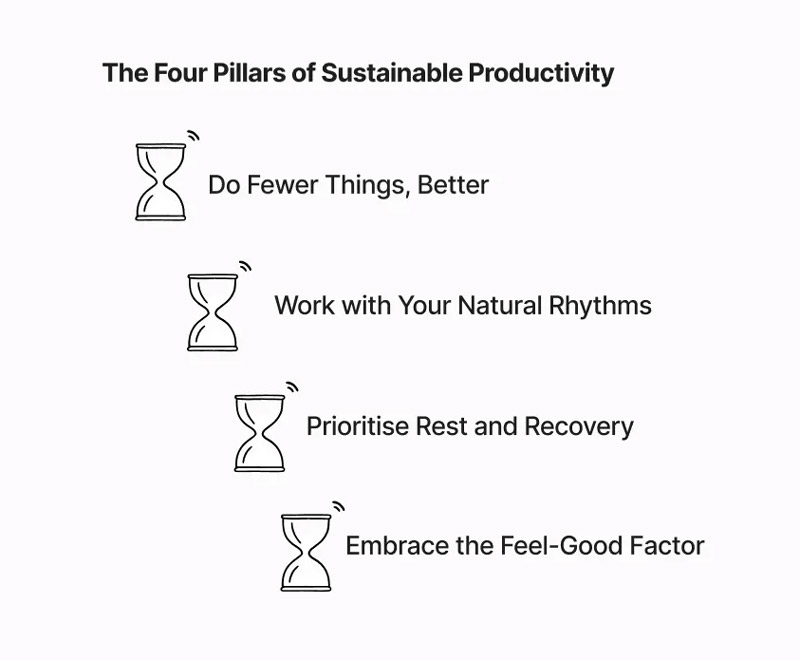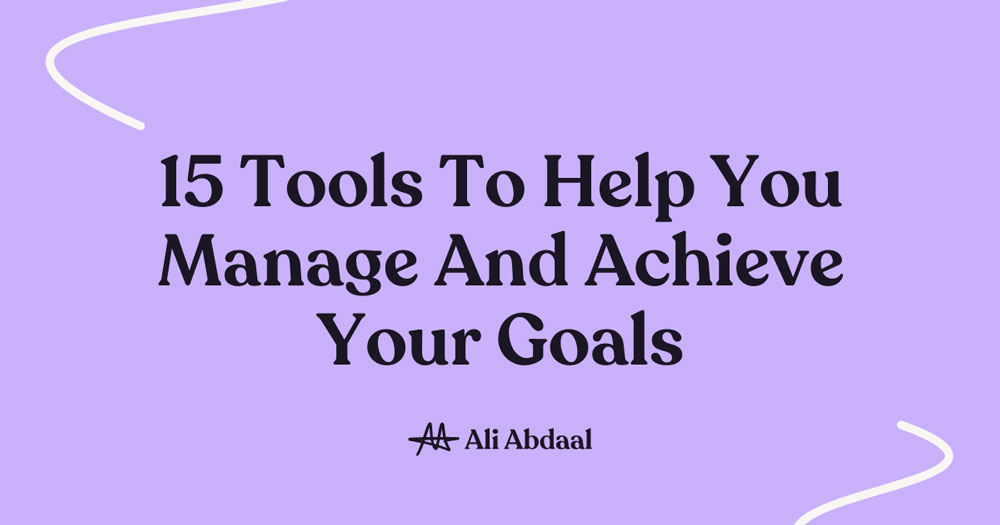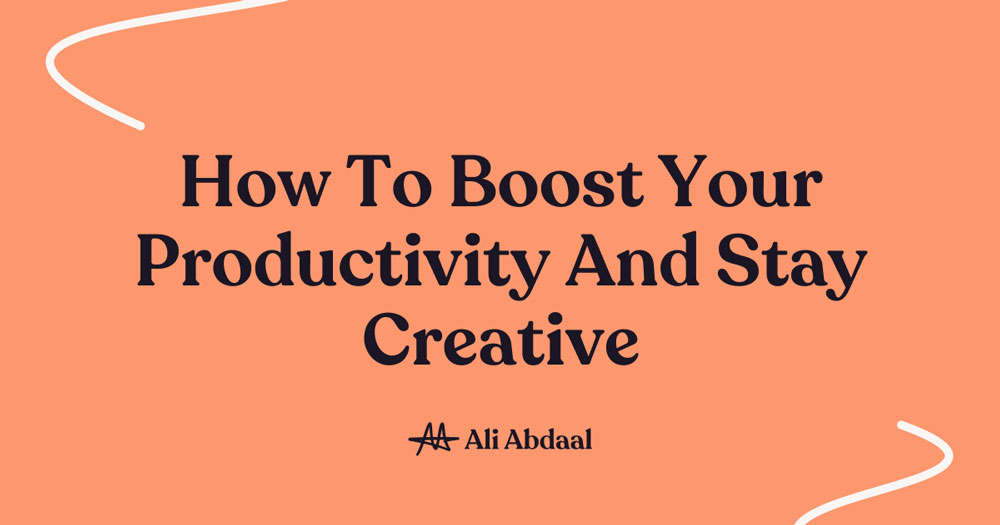In a world obsessed with hustle culture, many of us may find ourselves battling against ‘toxic productivity’.
When productivity is associated with getting things done in the most effective way, we can start to confuse productivity with busyness. You might spend a lot of time talking about getting things done – organising, questioning and analysing the work – without actually doing the work.
With pressure to produce quantity over quality, always trying to be more efficient, and an overflowing box of time management tools, many of us believe that busyness = productivity.
In his book Slow Productivity, Cal Newport refers to this constant busyness as “activity”, which has become the pseudo measure for productivity.
But what are some of the negative effects that all this busyness can lead to?
The Problem With Traditional Productivity
‘Activity’ as a proxy for productivity can create an unsustainable working habits. The grind can become unrelenting, leading to never-ending to-do lists, project timelines, and stress.
By squeezing every last drop of energy from ourselves, we can really suffer. We might experience things like:
Decreased Creativity – constantly overworking ourselves can make us feel stressed and overwhelmed. Our minds become cluttered and we lose our ability to work creatively.
Strained Relationships – without leaving any energy behind for our personal lives, we put strain on our relationships with friends and family. As we chase the grind we can neglect those around us.
Reduced Quality of Work – if we lack energy and feel tired, we’re more likely to make mistakes. The harder we try to catch up with the slipping deadlines, the more our quality suffers.
Burnout – at its worst, traditional productivity can lead to completely burning out. Feeling exhausted and apathetic towards our work, we might have to stop altogether and spend time recovering.
The Four Pillars of Sustainable Productivity
As an alternative approach, sustainable productivity focusses on prioritising our well-being so that we can consistently show up as our best selves.
Rather than relying on willpower and discipline, treating ourselves like machines in order to power through, we instead listen to the ebb and flow of our energy levels.
Sustainable productivity encourages us to work with our natural rhythms. finding a natural balance which allows us to make consistent progress towards our goals.
There are 4 key foundations of sustainable productivity:
- Do Fewer Things, Better
- Work with Your Natural Rhythms
- Prioritise Rest and Recovery
- Embrace the “Feel-Good” Factor

1. Do Fewer Things, Better
This is one of Cal Newport’s key ideas in Slow Productivity. You need to identify the most impactful tasks and focus on doing these as well as you can.
Removing the busywork and focussing on one task at a time enables us to apply ourselves much more effectively.
2. Work with Your Natural Rhythms
Our energy levels are not constant throughout each day, and they’re not consistent week on week.
Learn to listen to your body’s needs and adapt your schedule to suit what’s best.
Experiment with your peak performance hours and then plan your most important tasks accordingly.
3. Prioritise Rest and Recovery
To find a sustainable rhythm we have to prioritise regular breaks, downtime, and rest.
Recovery needs to become a necessity, not a luxury or a reward.
By scheduling our breaks, just like we do our work, we give ourselves time to recover instead of filling every waking moment with things to do.
4. Embrace the “Feel-Good” Factor
When we enjoy what we’re doing, we’re much more likely to stick with it in the long run.
We naturally have more energy when we’re having fun. We feel good which in turn boosts our productivity.
This boost leads to greater feelings of achievement, which makes us feel good all over again.
The release of all our feel-good hormones can help create a virtuous cycle – boosting both our energy and our productivity simultaneously.
How To Achieve Sustainable Productivity
To help you find your own sustainable productivity rhythm, we have 7 actionable strategies for you to try out, to help you build on these four pillars.
When using each of these strategies, think of yourself as a productivity scientist. You’re conducting experiments to find out which methods work best for you.
- Define Your ‘Why’
- Set NICE goals, not SMART goals
- Celebrate Your Wins
- Prioritise Your Energy, Not Your Time
- Optimise Your Environment
- Find your Daily Adventure
- Leverage the Power of Community
1. Define Your “Why” ❓
When you have a clear understanding behind why you need to do the thing, it becomes easier to stay motivated throughout each task.
Before starting each day, ask yourself the “5 whys” to outline and clarify your daily goals. If you really understand why a task is important, you’re much more likely to actually commit to it.
A great way to start this exercise is to ask yourself: “What is the one thing I can do today that will make me feel good about my day?”
For example, let’s say that you’re juggling work full time while also trying to write a novel. What would really make today a great day?
“Today would be a great day if I managed to write 3,000 words of my book”
Why?: “Because I’m feeling the pressure of the upcoming deadline and writing 3,000 words would help me get back on track.”
Why?: “I don’t want to miss this deadline so writing is important, but I also have other work I need to do.”
Why?: “I promised Charlie that I’d finish a report for him by Friday, and I have to get it done.”
Why?: “Charlie is a great client and keeping him happy is important to our business”
Why?: “Without Charlie’s work I’d be struggling financially”
By asking the 5 whys you’ve realised that the root cause of your pressure wasn’t the book publisher, but instead the report for Charlie that we’re currently neglecting.
This can help us reprioritise our workload to make sure Charlie receives his report on Friday. It might mean we need to delay our writing deadline slightly. But you can return to it hen you have a bit more time and less on your plate.
By asking ourselves why we need to complete a task 5 times, it can help us make sure we’re not wasting time on tasks that don’t really need our attention right now.
2. Set NICE Goals, Not SMART Goals 🎯
NICE goals are my own personal way of setting a sustainable working rhythm. They focus on adding an energising element to our short-term actions.
Traditional SMART goals (Specific, Measurable, Achievable, Relevant, Time-Bound) are great for monitoring the specific outcomes of a standardised task. But they can lead us to overlook whether the goal is actually important to us.
They’re great for an employer setting a task to an employee. But they might be less relevant for an entrepreneur assigning their own monthly goals.
Instead, we can use NICE goals that help prioritise the most important actions along our journey.
NICE stands for:
- Near-term – creating short milestones in our life to help us celebrate wins more often.
- Input-based – defining the necessary inputs & actions helps us to identify our immediate next steps.
- Controllable – by focusing on the things under our control we can make sure we’re not focussing on an external reward that we cannot guarantee.
- Energising – there may be multiple routes to achieve each goal, so we want to choose the process that will recharge our energy, not drain it.
By creating goals that are focused on our intrinsic motivation and outlining an energising path forward, we can build a sustainably productive schedule.
3. Celebrate Your Wins 🏆
When we celebrate a win, regardless of its size, our brains release a mixture of feel-good hormones.
These hormones boost our motivation and energy, reinforce positive behaviour, and help us create a positive mindset.
But contrary to popular belief, it’s not the success that leads to us feeling good. It’s feeling good that leads to success.
Therefore we want to try and celebrate as many wins as possible, to sustainably boost our productivity.
To do this, we can use the strategy of “Find the Win”. We can use the format of “I didn’t do X, but I did do Y” to help us find the win in almost any situation.
One example would be “I might have overslept and missed my morning run, but I now feel fully recovered and I’ll have an energy boost for the rest of the day”.
Even if we’re facing a setback or feeling disappointed, we can always find something to celebrate, however small it may be.
4. Prioritise Your Energy, Not Your Time ⚡
Trying to optimise every second of every day with meticulous time management can be overwhelming. Often we try to squeeze in multiple projects and meet numerous deadlines all at once. Instead, we can use something called the Energy Investment Portfolio to simplify our schedules.
The Energy Investment Portfolio helps us prioritise a small number of active projects. We can then pause all other projects and return to them later. This makes us more intentional and effective with the way we spend our time.
So how does it work?
We take a blank piece of paper and create two columns. One is for our currently active projects and one is for our backlog.
Then, we organise all of our projects into these two lists, making sure only the essential projects make it onto our active list.
Once we’re happy with our two lists, we can then share this document with our managers and business partners to let them know what we’re currently working on.
This is great for a number of reasons. First, it helps us create boundaries for how many different projects we are managing at any one time. Focussing on a small amount of between 1-3 active projects helps us work much more effectively.
Second, it helps us react to the changing demands of our business. If a new project suddenly becomes urgent, we can quickly see which active projects we will need to pause or delay.
Finally, it gives us an overview of the projects sitting in our backlog that we might never get around to. It helps us identify and remove any projects that aren’t necessary, simplifying our workload.
5. Optimise Your Environment 🌿
Another strategy to help create a sustainable workflow is to create an optimised environment.
Studies show that a cluttered desk leads to a loss of focus and a dip in productivity.
Taking time away from work to tidy your workspace may seem counterproductive at first. But just a 10-minute declutter each morning can have a significant effect on your mood.
By creating an enjoyable workspace and removing unnecessary distractions, we can boost our productivity whilst also taking a quick pause from our work.
If you’d like to read more about creating the ultimate productive workspace, we have articles
6. Find Your Daily Adventure 🗺️
Adding an element of play into our lives is a great way to boost our energy and productivity.
At the start of each day, try looking for a ‘daily adventure’.
What is the one most important thing that you need to get done, and how can you achieve it in an adventurous way?
This really just means to look for a new creative or unexpected solution. Can you make the barista laugh with a joke when you pick up your morning coffee? Can you finish writing your essay before The Pirates of The Caribbean soundtrack comes to an end?
By reframing your day into an adventure, it reminds you to look for the fun and enjoy the journey, leading to a more sustainable process.
You might like to remind yourself to look for the daily adventure by attaching a little post-it-note to your monitor screen which reads:
“What would this look like if it were fun?”
How can you get creative? Can you add music, a sense of competition, or a reward to the end of the process?
🖼️ This simple trick works so well that you might also like to have it as your iPhone wallpaper.
Approaching your work with the spirit of adventure can help you find the fun in whatever you’re doing.
7. Leverage the Power of Community 💪
Jim Rohn famously said “You are the average of the five people you spend the most time with”.
Psychologist Albert Bandura found that surrounding ourselves with high-achieving individuals raises our self-efficacy (our self-belief). This in turn increases the likelihood of our own success.
Or to put it simply, being part of a community who are all overcoming similar challenges raises your belief in your own capabilities.
There are many different ways to access the leveraging effect of community. We can take part in co-working sessions, attend group workshops or even find a personal accountability buddy.
Experimenting with different ways to invite other people into your work can help boost your energy and motivation throughout each day.
In fact, the energising effects of the community are so powerful that I decided to create my on online community, Productivity Lab.
If you’d like to see how Productivity Lab could help you benefit from the power of community, you can find more details over here.
Enjoy The Journey
Traditional productivity can lead us to obsess over activity and busyness. We try and squeeze every drop of energy out of each day.
Sustainable productivity offers us a different way. We can slow down and prioritise our well-being.
By aligning our work to our natural rhythms, we can create a more balanced, fulfilling and ultimately more effective way to achieving our goals.
It’s about creating a sustainable process that allows you to thrive in all areas of your life
Using the above strategies, we can focus on boosting our energy, prolonging our motivation and benefiting from the feel-good effects of having fun.
We can move away from the toxic grind culture and enjoy the journey instead 🙂
And, if you’re looking to get the most out of the time you do spend working, I recommend checking out Spark 2025. It’s an online summit I’ll be running between the 4th-5th January 2025, designed to help you build your own sustainable productivity systems to get stuff done. You can reserve your free spot here.




